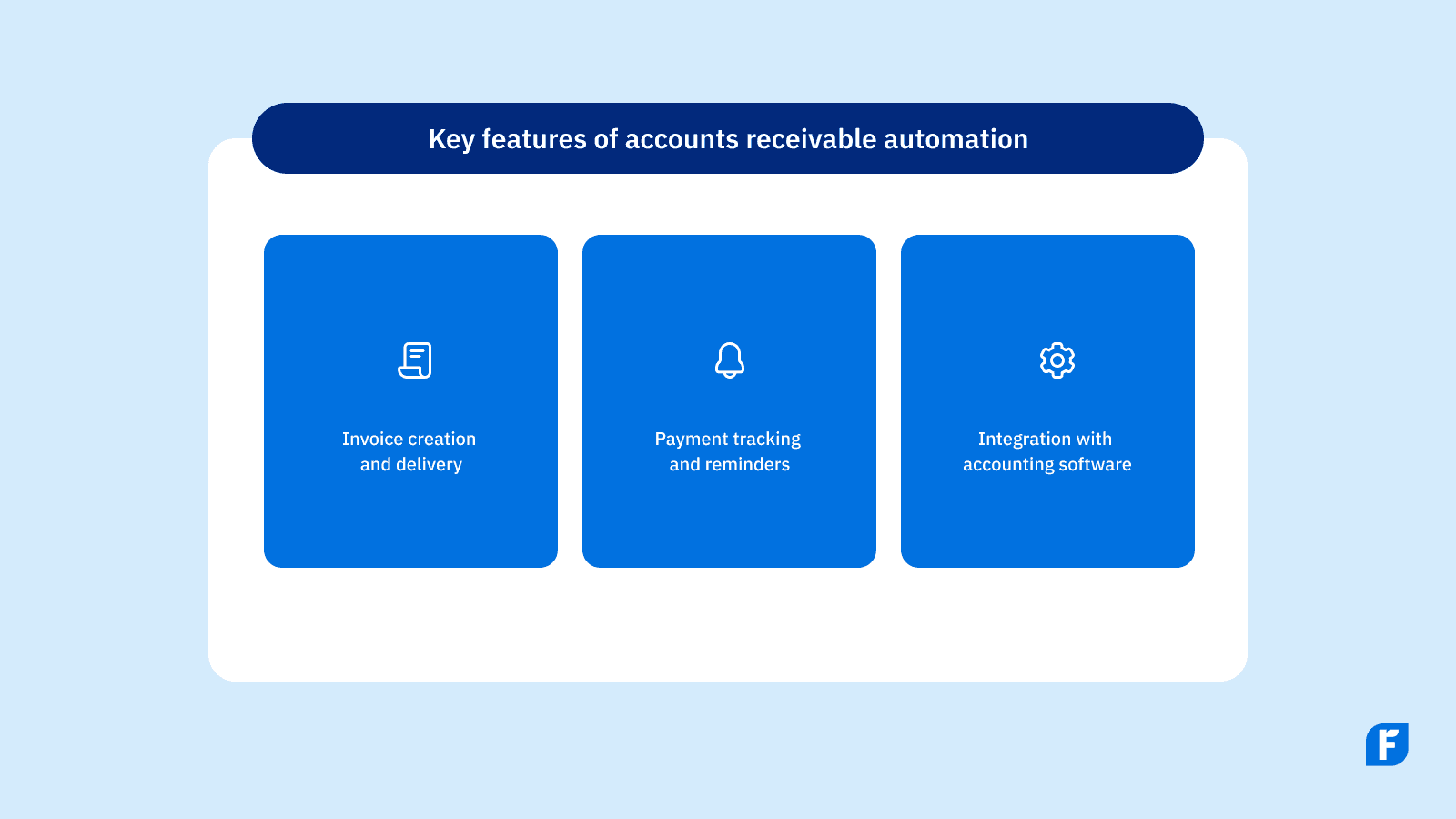Automate Accounts Receivable: How to Speed Up Payments and Improve Cash Flow
Updated on October 3, 2025 | 8 min. read
🌟 KEY TAKEAWAYS
Automate accounts receivable to get paid faster and more consistently.
Accounts receivable automation software reduces manual processes and human error in your billing cycle.
Set automated payment reminders and track overdue invoices in one place—integrated with accounting software like FreshBooks.
Better cash flow management = stronger financial stability.
Need to improve your business’s cash flow? Having issues collecting payments from your clients? Accounts receivable automation might be the answer you’re looking for.
What does it mean to automate accounts receivable?
Automating accounts receivable (AR) is simpler than it sounds. You swap manual steps like creating invoices, recording payments, and chasing overdue bills for software that does it for you. With the right accounts receivable automation software, you can set automated payment reminders, reduce errors, and improve cash flow management, all while keeping your books up to date.
Accounts receivable, in plain English
Accounts receivable (AR) is simply the money customers owe your business after purchases on credit. It’s still an asset on your accounting balance sheet because you’ve already delivered the product or service, you’re just waiting to get paid.
Tracking AR can be a time-consuming grind, but it’s essential for healthy cash flow. That’s where accounts receivable automation comes in. Instead of manual work, you set up automated invoice generation, payment tracking, payment reminders, and even payment collection to run in the background.
The payoff? Cost savings, fewer errors, and faster payments. You free up your time (or the time of your team) to focus on higher-value work instead of chasing online payments or sending billing reminders.
Manual processes vs. receivable automation
Manual AR means repetitive manual data entry: generating invoices, emailing them, logging payments, and following up. It’s slow and error-prone (wrong totals, missed invoices).
Still, plenty of businesses still rely entirely or in part on manual processes. A 2024 study showed that more than a third of companies have not automated their AR process and a quarter still rely on spreadsheets.
Receivable automation handles the same steps, from invoice generation to payment collection, more quickly and more accurately. The upside? Healthier cash flow as you get paid faster and more reliably.
How accounts receivable automation works
The automated accounts receivable process works as follows:
Invoice creation and delivery
Accounts receivable automation software automatically generates invoices, finding the money owed on sales or service records and creating professional, customized, and branded invoices, streamlining the invoicing process.
Payment tracking and reminders
AR software will monitor outstanding invoices and send automated reminders to clients to accelerate payments. With accounts receivable automation, you can improve customer satisfaction and reduce late payments by:
- scheduling follow-ups for before the due date
- sending follow-ups on the due date
- sending reminders after the due date for faster payments
Integration with accounting software
Connecting software products and tools is a great feeling, especially when you know that integration is going to save you even more time every week. Connect your AR tools with your accounting software so invoices, payments, and customer records update in real-time. That keeps your accounts receivable process clean and your reports accurate.

Benefits of automating accounts receivable
Automating accounts receivable turns a slow, manual routine into a simple, set-it-and-forget workflow. With the right accounts receivable automation software, invoices go out on time, payment reminders fire automatically, and your records stay in sync without the copy-paste and follow-ups.
The payoff shows up where it matters: faster payments, fewer late invoices, steadier cash flow management, and a finance team that can focus on higher-value work instead of data entry.
Below are the biggest benefits you’ll see once your accounts receivable process is automated.
Faster customer payments
Automated invoicing and monitoring reduce invoice-to-payment time. Timely payments lead to stronger cash flow management and an improved relationship between vendors and customers.
Improved accuracy and reduced errors
Successful accounts receivable automation software implementation will eliminate common manual mistakes like incorrect totals or missed invoices. With consistent tracking, automated systems ensure no invoice is overlooked.
Better cash flow visibility
Use real-time dashboards to monitor outstanding invoices, credit management, and cash position. Track KPIs like Days Sales Outstanding (DSO) to see progress over time.
Understanding your current financial position allows you to make better business decisions and take more risks, so you can grow your company faster.
Limitations of accounts receivable automation
Automation isn’t simply magic. It’s more like a really good co-pilot. Accounts receivable automation takes the repetitive work off your plate, but it still relies on clean data, clear rules, and human judgment when things get messy. To get the most from your AR automation tools (and protect cash flow), plan for the spots where software can’t go it alone: data quality, edge cases, and customer conversations. Here are the key limitations to keep in mind before you automate your accounts receivable process.
Data accuracy and setup requirements
When implementing AR automation, you must ensure the customer and invoice data are accurate. Poor setup will lead to incorrect billing and other problems with accounts receivable management.
The need for human oversight
AR automation tools are great for reducing manual accounts receivable processes, but you still need staff to handle more complex issues like disputes, exceptions, and special payment arrangements.
You also need a human touch to manage customer relationships. Automation should enhance, not replace, your business systems and your team’s financial management skills.

How to choose the right AR automation solution
Choosing the best AR automation solution is crucial to improving your business’s cash flow. Here’s how to find the right solution:
Key features to look for
Some key features your AR solution should have are:
- multi-channel invoice delivery, like emails and customer portals
- customizable automated reminders and late-fee policies
- integration with your existing accounting software
- strong security features to handle sensitive customer payment data
Evaluating AR automation software options
When choosing software to automate your AR processes, you’ll want to consider:
- scalability
- ease of use
- customer support
Automating your accounts receivable is more than generating invoices quickly. With the right software, you can customize your invoices, track expenses, generate comprehensive financial reports, and monitor your business’s cash flow and accounts payable in real-time.
Automate your AR process and make life easier with FreshBooks
An AR automation solution will improve your accounts receivable processing speed, accuracy, and cash flow, saving you time, reducing stress, and improving your business’s financial health.
When you choose FreshBooks accounting software to automate invoicing processes and credit management, you improve the customer experience by providing multiple payment options, customer portals, and making customer payments easier.
Start your free FreshBooks trial today and see how easy it is to automate your accounts receivable process.
Frequently asked questions
How do I automate my accounts receivable process?
Start with the workflow you already use, then replace the manual steps with accounts receivable automation software:
- Map your accounts receivable (AR) process (invoice generation, delivery, payment processing, follow-ups).
- Choose the right AR automation software that integrates with your accounting software (e.g., FreshBooks).
- Set up branded invoice templates, payment terms, late-fee rules, and customer portals with multiple payment options for online payments.
- Turn on automated payment reminders (before, on, and after the due date) to accelerate payments and reduce late payments.
- Sync data so invoices, collecting payments, and customer records update in real-time, no more manual data entry.
- Track outstanding invoices, cash flow management, and Days Sales Outstanding (DSO) on dashboards to confirm results.
This replaces time-consuming processes and repetitive tasks with an automated process that improves accuracy and customer experience.
Is accounts receivable automation expensive?
Pricing varies by provider and feature set (users, invoice volume, advanced collections, analytics). For a small business, look for a plan that scales with you. Most teams see cost savings by cutting manual processes, reducing human error, and shortening DSO, freeing your finance team to focus on higher-value work like credit management and reporting. The right AR automation solution often pays for itself through faster payment collection and steadier cash flow.
Can AR automation improve my cash flow?
Yes. Automating accounts receivable helps you get faster payments and fewer overdue invoices. Automated reminders and easy online payments shift customer payment behaviors, reduce late payments, and lower DSO. You also gain better cash flow visibility for decisions that protect your business’s financial health—all while improving customer satisfaction with clearer invoices and self-serve customer portals.
Does AR automation work with my accounting software?
Most modern accounts receivable software integrates directly with your accounting software (like FreshBooks). That means real-time sync for invoices, payments, and customer records—no double entry, fewer mistakes. Integration keeps accounts receivable management clean, ensures reports stay accurate, and streamlines both receivable processes and related business systems. Some tools also surface insights alongside accounts payable to give a fuller picture of cash flow.
What features should I look for in AR automation software?
Prioritize features that reduce friction and speed up cash:
- branded invoice templates and invoice generation with clear payment links
- automated payment reminders and configurable dunning/late-fee rules
- customer portals and multiple payment options for timely payments
- two-way integration with your accounting software (e.g., FreshBooks) and/or ERP systems
- real-time dashboards for outstanding invoices, cash flow, and DSO
- roles/permissions, audit trails, and strong security for sensitive data
- flexible APIs and webhooks (if you need custom flows)
- responsive support and a roadmap that scales as you grow
These capabilities help automate accounts receivable, reduce human error, empower finance teams, and improve cash flow—the core key benefits of AR automation tools.







